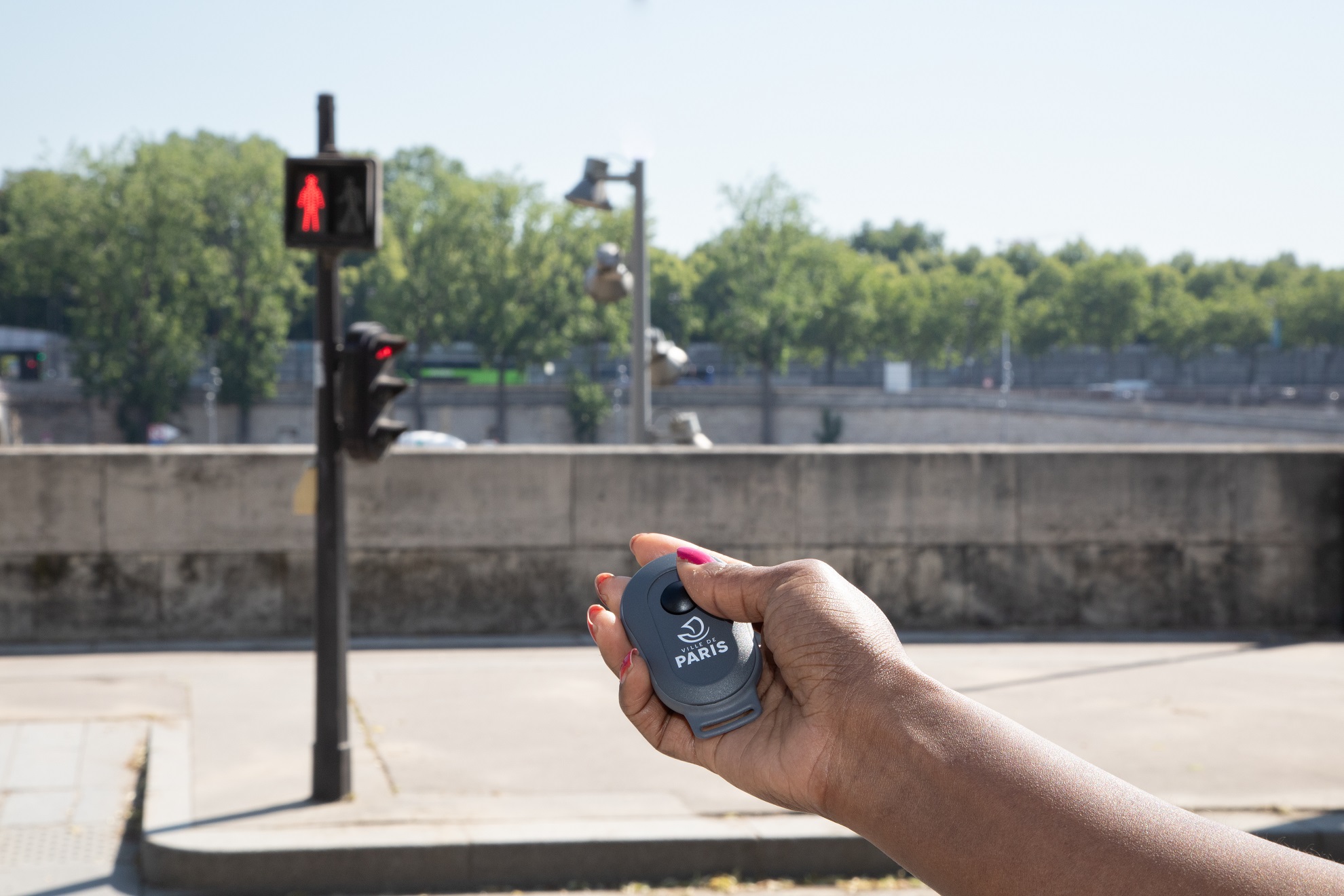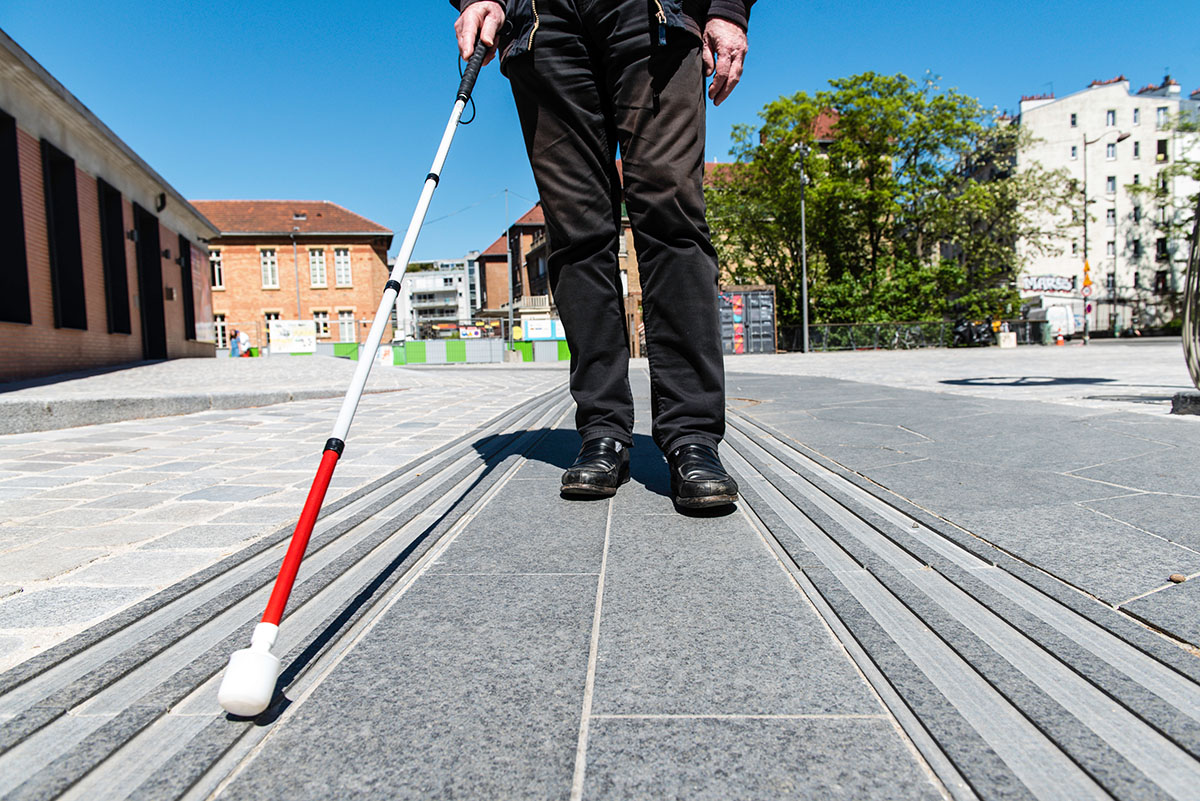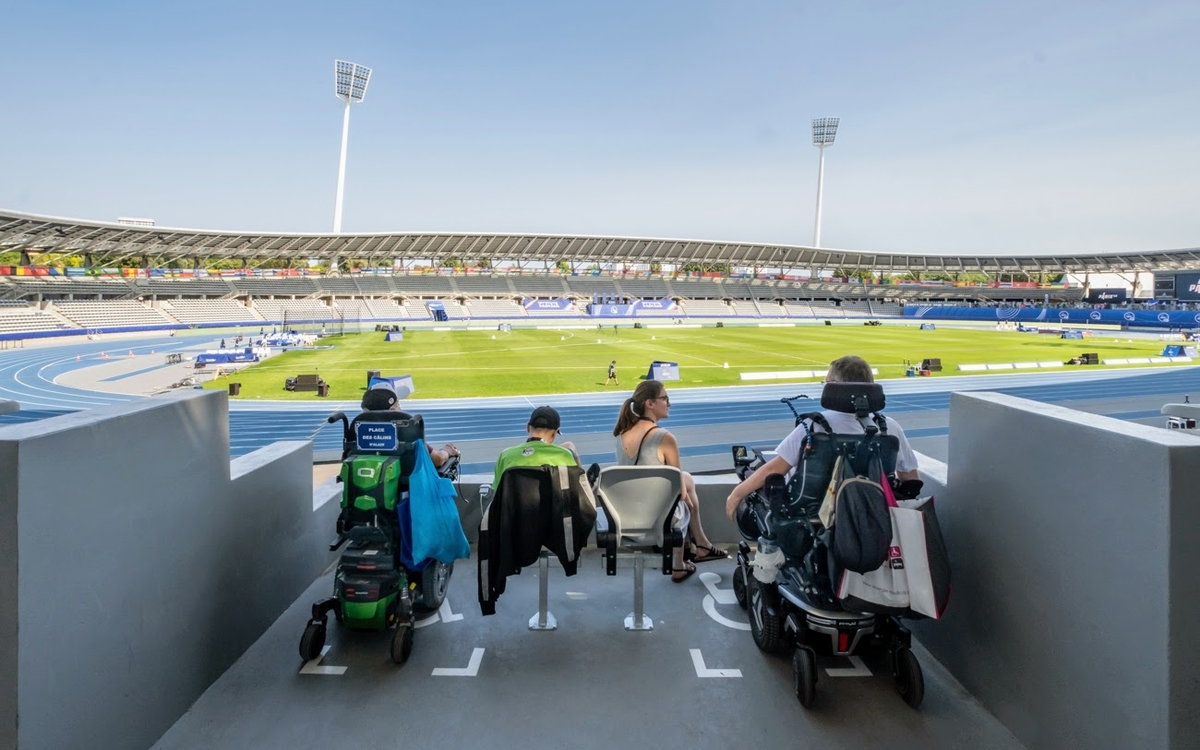Content
Cette page est aussi disponible en français
With some 350,000 visitors with disabilities expected to visit Paris during the Games, the city has stepped up its accessibility not only around the Olympic venues and festivities… but also within them, so that people with all kinds of disabilities can enjoy the experience to the full. While some of these improvements are temporary, most will continue to benefit Parisians once the event is over.
Lowering sidewalks, sounding traffic lights, providing equipment adapted to different disabilities are just some of the major improvements the city of Paris has undertaken ahead of the Olympic and Paralympic Games. This involves both structural improvements to urban spaces and temporary installations during sporting events. Find out what's going on!
A panel of expert associations
To improve spectators and visitors with disabilities experiences, a panel of accessibility experts made up of members of five disability associations, as well as the Paris Tourism Office, Paris 2024 and event production agencies, has been meeting once a month since November 2022.
CRAIF - Autism Resource Centre Île-de-France
Unanimes - Union of national associations for the inclusion of the hearing impaired and deaf
Association Valentin Haüy - With the blind and partially sighted
APF France Handicap
Action handicap France - Disability training and awareness
Facilities that will stay on
These improvements initially involved repairing damaged or non-functional pavements, and making road crossings safer by lowering kerbs, creating warning and guide strips, crosswalks, clearing pathways, and sounding traffic lights.

A remote control for beepers.
Crédit photo :
Christophe Belin / Ville de Paris

Guide strip on promenade Jane-et-Paulette-Nardal (14th).
Crédit photo :
Emilie Chaix/Ville de Paris
In addition to the 10,400 sound modules already present, 2,500 new ones (at around 300 intersections) have been installed in preparation for the Paris 2024 Games. Universal remote controls have also been distributed (including 300 via the Valentin Haüy association). Sound systems were also installed at bus stops, in conjunction with JCDecaux, the company responsible for operating the stops.
Over the past two years, the city has invested 22 million euros to make all bus lines accessible where possible. As a result, 59 of the 61 lines are now accessible to people with disabilities!
The heritage of hyper-accessible neighborhoods
Hyper-accessible neighborhoods are "exemplary zones" enabling anyone, whatever their situation (families with baby carriages, the elderly, people with disabilities…), to get around easily and have access to municipal services within a so-called "quarter-hour" perimeter. The hosting of the Paris 2024 Games has expedited the development of hyper-accessible neighborhoods, allowing this initiative to materialize within 18 to 24 months instead of the originally projected two decades.
Temporary facilities
Guidance
The unique use of certain sections, such as roadways being used by pedestrians instead of vehicles, has led to temporary measures being implemented to address disruptions and discontinuities along the path. Accessible signage has also been put in place, complemented by human signage provided by volunteers along the entire route, which also includes areas for rest, calm and freshness.
To carry out these temporary improvements to venue surroundings, the City has invested 280,000 euros and acquired a stock of equipment: 150 ramps of different sizes, 150 linear meters of softened cable grommets. Most of this equipment can be re-used, after the Paralympic Games, in Parisian establishments to improve their accessibility.
Accessibility patrols
To ensure the quality of the experience for spectators and visitors with disabilities, 19 disability liaisons from different City departments conducted patrols to pinpoint any challenges faced. Altogether, this amounted to more than 100 half-day patrols.
Transportation and parking zones
Drop-off/pick-up zones have been set up to bring disabled people travelling to the venues as close as possible to the entrances via the shuttle service set up by Île-de-France Mobilités (IDFM). Up to five departures per hour are scheduled from each of the major Paris stations to each of the Paralympic venues. This service can be booked up to 48 hours before the session, via this website.
Adjacent to each drop-off/pick-up zone, there is a parking area available for the private vehicles of individuals with disabled permits, no reservation required.
Reception points and trained volunteers
To make Paris more inclusive, the volunteers took two training courses, one of which involved role-playing. They have also been introduced to French sign language, learning around 30 different signs. These volunteers will be present at reception points, at each drop-off/pick-up zone and at certain important public transport service points. They are there to guide and assist disabled spectators, right up to the entrance if necessary.
At these reception points, spectators can borrow equipment (such as noise-cancelling headphones), find a dog-friendly area set up for assistance dogs, or request assistance with moving around via a wheelchair operated by a volunteer. For people with invisible disabilities, a lanyard is available, discreetly signaling specific needs to all volunteers and staff who are familiar with the meaning of the lanyard.
An interactive map dedicated to accessibility
The My Paris Je T'aime tourist office offers an online map listing transport and itineraries, cultural venues, restaurants and accommodation accessible to people with disabilities. Consult the map.
Helping you to enjoy the Games, whatever your disability
Easy access to competitions and festivities is the first step. The next step is to make the most of it, whatever your disability! As part of the Olympic and Paralympic Games, the city has purchased equipment that it can then be redistributed to various players, associations and establishments in hyper-accessible neighborhoods.
The portable magnetic loop
This device enables hearing-impaired or deaf people with hearing aids to hear the sounds emanating from microphones. If you are hard of hearing, you can use the headset, and if you have a hearing aid, you can use the neckband.
This system is designed for hearing-impaired or deaf volunteers at operational bases, and for journalists at the Paris Media Center (PMC).
The counter magnetic loop
The BIM Guichet system enables people with or without hearing aids to listen directly to the sound emanating from a BIM microphone. Simply speaking into the microphone allows sound to be transmitted to the hearing aid. If they do not have a hearing aid, they can use an earpiece instead.
This system is designed for deaf and hearing-impaired spectators at the various competition and festivity venues and for journalists at the Paris Media Center.
Wheelchairs
Wheelchairs can be lent out at festivity sites and driven by volunteers to accompany a person with mobility difficulties.
This system is intended for spectators with mobility difficulties at the festivities sites and surrounding competition venues. Wheelchairs are also available at the PMC for journalists.
OMNI electric scooters
Any wheelchair user can rent an OMNI device, which consists of a motorized third wheel for wheelchairs (from €50/day). These scooters are also made available free of charge to volunteers who request them to carry out their mission. They are also available to spectators on the Terrasse des Jeux (the festivities site on the forecourt of the Hôtel de Ville) and at the PMC for journalists on organized visits.

Attachment for using electric scooters in wheelchairs.
Crédit photo :
Jean-Baptiste Gurliat / Ville de Paris
Noise-reducing headphones and earplugs
They diminish ambient noise and are beneficial for individuals with autism, mental or psychological disorders, and those who are hypersensitive to noise. The headphones are only available on loan and must be returned after each use (earplugs are donated).
This material is available on the festivities sites, on the approach zones to the competition sites and at the PMC for journalists.
Accessibility tablets
These tablets are equipped with specific accessibility applications:
-
Seeing AI: artificial intelligence application for the visually impaired that uses the camera to identify people or objects.
-
Be my eyes: collaborative application that helps visually impaired or blind people deal with everyday situations: thanks to a live video call, volunteer users provide visual assistance to describe a situation.
-
Office Pack: enables voice dictation via Word and instant translation via subtitles on PowerPoint.
-
Streetnave: a GPS that adapts routes to suit different disabilities.
These tablets are reserved for volunteers assigned to the accessibility mission and for disabled volunteers.
Sunflower cords and card
These lanyards enable people to show that they have a hidden disability and that they need special attention.
This material is available on the festivities sites, surrounding competition sites and at the PMC for journalists.
Ergonomic tableware
Specifically, it is accessible to individuals facing pre-emption challenges. Availability spans festival locations, operational centers, and the Press Media Center for journalists.
These sports facilities renovated for the Paris 2024 Games
All the competition venues, the Athletes' Village and the Media Centre have been designed to be accessible to all. In Paris, several sports facilities were renovated prior to the Games to improve reception conditions and guarantee accessibility for all:
-
Pierre de Coubertin gymnasium (16th)
-
Max Rousié stadium (17th)
-
Poissonniers sports center (18th)
-
Dauvin sports center (18th)
-
la piscine Georges Vallerey (20th)
By the end of 2024, 80% of the facilities of the Youth and Sports Department will be accessible to people with disabilities.
Get all the news on disruptions and opportunities
related to the Games with the Paris Infos Jeux 2024 newsletter.
We want to hear from you!
Was this information useful to you?
Please note: we cannot reply via this form (please do not include any personal information).
